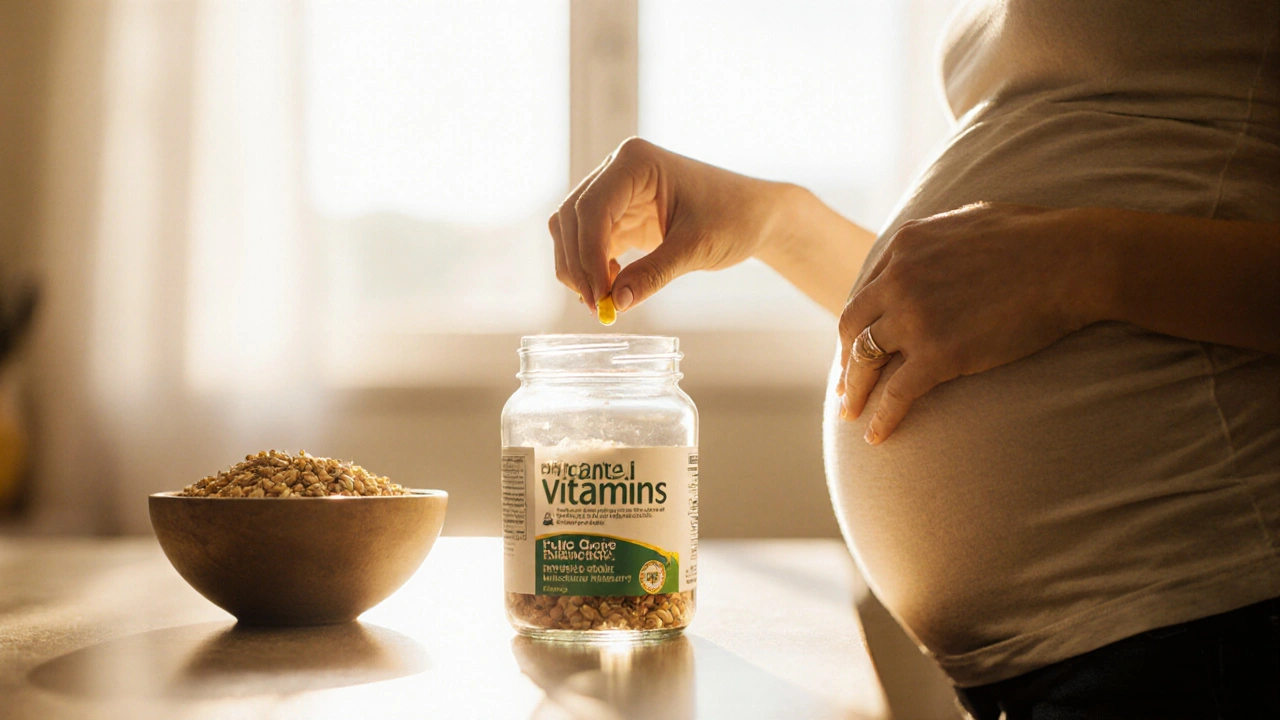Folate Supplement Selector
Select Your Situation
Answer the following questions to get personalized recommendations for folate supplements.
Your Recommended Supplement
When it comes to preventing birth defects, supporting heart health, and keeping homocysteine levels in check, many people reach for folic acid. But the market is flooded with alternatives-methylfolate, folinic acid, 5‑MTHF, and other forms of vitamin B9. Knowing which one fits your needs isn’t a guessing game; it’s about chemistry, bioavailability, and personal health goals. Below you’ll find a straight‑forward rundown that lets you compare the most common folate supplements side by side, see where each shines, and avoid common pitfalls.
Key Takeaways
- Folic acid is the synthetic, inexpensive form used in fortification, but it requires conversion in the liver.
- Methylfolate (5‑MTHF) is the active, bio‑available form that skips the conversion step, making it ideal for those with MTHFR gene variants.
- Folinic acid (5‑formyl‑THF) is a reduced form useful in chemotherapy and certain metabolic disorders.
- Dosage recommendations differ: 400µg for most adults, 600-800µg for pregnant women, and up to 1mg for specific cardiovascular support.
- Safety profile is excellent across the board, but high doses (>1mg) may mask B12 deficiency.
What is Folic Acid?
Folic Acid is a synthetic form of vitamin B9 that was first synthesized in the 1940s. It is the version added to grain products and the basis of most over‑the‑counter supplements. In the body, folic acid must be reduced by the enzyme dihydrofolate reductase (DHFR) before it can enter the folate cycle, a series of reactions critical for DNA synthesis, methylation, and amino‑acid metabolism.
Because the conversion process can be slow or incomplete in some individuals, the amount of active folate reaching the bloodstream may be lower than the label suggests.
Popular Alternatives to Folic Acid
The term “folate” covers several naturally occurring compounds. The most common alternatives you’ll see on supplement labels are:
- Methylfolate (also called 5‑methyltetrahydrofolate or 5‑MTHF). This is the methylated, biologically active form that the body can use directly for methylation reactions.
- Folinic Acid (5‑formyl‑THF). It bypasses the DHFR step and feeds directly into the folate cycle, often prescribed in oncology settings.
- Pure Vitamin B9 found in whole‑food extracts. These contain a mix of natural folate forms but can be unstable in supplement form.
- 5‑MTHF - essentially the same molecule as methylfolate, marketed under different brand names.
Comparative Table: Folic Acid vs. Alternatives
| Attribute | Folic Acid | Methylfolate (5‑MTHF) | Folinic Acid | Food‑Derived Vitamin B9 |
|---|---|---|---|---|
| Form | Synthetic, oxidized | Active, methylated | Reduced, 5‑formyl | Natural polyglutamates |
| Conversion Needed? | Yes (DHFR) | No | Partial (enzyme bypass) | Partial (gut enzymes) |
| Typical Dosage (Adults) | 400µg - 1mg | 400µg - 1mg | 400µg - 800µg | Varies (food equivalents) |
| Pregnancy Recommendation | 600-800µg | 600-800µg | 600-800µg (under medical supervision) | Equivalent to 600-800µg |
| Best For | General population, fortification programs | People with MTHFR variants, higher methylation needs | Chemotherapy support, rare metabolic disorders | Those preferring whole‑food sources |
| Cost (per 30‑day supply) | Low | Moderate‑High | Moderate | Variable, often higher |
When to Choose Folic Acid
If you’re buying a general multivitamin or a prenatal supplement that follows national fortification guidelines, folic acid is usually the cheapest and most widely studied option. Public health programs in the UK, US, and EU rely on folic acid fortification to reduce neural tube defect (NTD) rates by up to 30%.
Typical scenarios:
- Women planning to conceive or in the first trimester of pregnancy.
- Adults seeking a basic dietary supplement without specific metabolic concerns.
- People on a tight budget who still want the proven NTD protection.

Why Some People Prefer Methylfolate
Genetic variations in the MTHFR (methylenetetrahydrofolate reductase) gene affect how efficiently the body converts folic acid to its active form. About 30% of people of European descent carry at least one reduced‑function allele. For these individuals, taking methylfolate can bypass the bottleneck, ensuring adequate methylation for DNA repair, neurotransmitter synthesis, and cardiovascular health.
Additional benefits reported in small clinical trials include:
- Lower homocysteine levels compared with folic acid at equal doses.
- Improved mood scores in people with depression.
- Reduced migraine frequency in certain patients.
Because methylfolate is already in the active form, the risk of unmetabolized folic acid-a potential concern for immune modulation-is essentially eliminated.
Folinic Acid: The Niche Player
Folinic acid (also called leucovorin) is mainly prescribed when a patient needs to counteract the toxic effects of methotrexate chemotherapy or to treat folate‑deficiency anemia that doesn’t respond to folic acid. It enters the folate cycle after the DHFR step, making it useful when that enzyme is inhibited.
Typical use cases include:
- Adjunct therapy for certain cancers.
- Patients with rare congenital folate metabolism disorders.
- Those on high‑dose methotrexate who need rescue supplementation.
Because it’s a prescription‑only product in many countries, folinic acid isn’t a common over‑the‑counter alternative, but it’s worth mentioning for completeness.
Safety, Interactions, and Common Pitfalls
All folate forms have an excellent safety record when taken within recommended limits. However, there are a few points to watch:
- Masking B12 deficiency: Doses above 1mg/day can hide the anemia caused by vitamin B12 deficiency, potentially leading to nerve damage.
- Drug Interactions: Anticonvulsants (e.g., phenytoin) and certain antibiotics can lower folate levels, increasing the need for supplementation.
- Excessive Intake: Very high intakes (>5mg/day) have been linked in some epidemiological studies to an increased risk of certain cancers, though the data are inconclusive.
Choosing the right form helps mitigate some of these concerns. For instance, methylfolate’s direct bioavailability means you can often achieve the same therapeutic effect at a lower dose, reducing the chance of excess unmetabolized folic acid.
How to Pick the Right Folate for Your Situation
- Identify your primary goal. Pregnancy protection? Cardiovascular health? Managing a genetic variant?
- Check for MTHFR status. A simple saliva test can reveal whether you carry reduced‑function alleles. If you do, methylfolate is usually the safest bet.
- Consider other medications. If you’re on methotrexate, folinic acid might be the only appropriate choice.
- Assess budget. Folic acid is cheapest; methylfolate is pricier but may require a lower dose.
- Consult a healthcare professional. Particularly during pregnancy or when managing chronic conditions.
Most people will find a standard prenatal vitamin that already contains the right form and dose, so there’s rarely a need to buy separate supplements unless a specific medical recommendation exists.
Mini‑Checklist: Choosing Your Folate Supplement
- Goal: NTD prevention → folic acid 400‑800µg.
- Goal: MTHFR variant → methylfolate 400‑800µg.
- Goal: Chemotherapy rescue → folinic acid (prescribed).
- Budget <£10/month → folic acid.
- Prefer whole‑food source → food‑derived vitamin B9 (e.g., leaf‑green powders).
Frequently Asked Questions
Can I take both folic acid and methylfolate together?
Generally you don’t need both. If you’re already taking methylfolate, adding folic acid usually offers no extra benefit and may increase unmetabolized folic acid levels. Speak with a clinician if you’re considering a combination for a specific health condition.
What dosage of folic acid is safe during pregnancy?
The UK NHS recommends 400µg daily for women of child‑bearing age, increasing to 600µg during the first twelve weeks of pregnancy. Some guidelines suggest up to 800µg if you have a history of NTDs.
Is methylfolate better for heart health?
Studies show methylfolate can lower homocysteine more efficiently than folic acid, and high homocysteine is a risk factor for cardiovascular disease. However, evidence that supplementation directly reduces heart attacks is mixed. It’s a reasonable option if you have elevated homocysteine or an MTHFR variant.
Can high doses of folic acid mask a vitamin B12 deficiency?
Yes. Doses above 1mg per day can correct the anemia caused by B12 deficiency without fixing the neurological damage. If you’re elderly or have a known B12 issue, keep folate intake below that threshold or use methylfolate, which does not mask B12 deficiency.
Are there natural food sources that provide the same benefit as supplements?
Leafy greens (spinach, kale), legumes, and fortified cereals deliver natural folate. The amount varies, and cooking can reduce bioavailability, so many people still supplement to guarantee a consistent intake, especially during pregnancy.

Next Steps & Troubleshooting
If you start a new supplement and notice side effects such as gastrointestinal upset or unusual fatigue, consider these actions:
- Check the dose-most side effects disappear when you drop to the low end of the recommended range.
- Switch the form-some people tolerate methylfolate better than folic acid, or vice versa.
- Get a blood test-measure serum folate and homocysteine to see if the supplement is working.
- Consult your GP or a dietitian-especially if you have a chronic condition or are pregnant.
By aligning your supplement choice with your health goals, genetic makeup, and lifestyle, you’ll maximize the benefits of folate without unnecessary expense or confusion.


18 Comments
Amy AimsOctober 1, 2025 AT 22:43
Great overview, thanks! 😊
Shaik BashaOctober 2, 2025 AT 12:36
Yo bro, this post actually clears up the whole folate mess lol. I was always like “folic what??” and now I get why some peeps swear by methylfolate. Also, the table is 🔥 – makes picking stuff super easy. If you’re on meds like methotrexate, definitely check the folinic part, don’t play around.
Michael IeradiOctober 2, 2025 AT 20:56
I appreciate the enthusiasm, but a quick reminder: always consult a healthcare professional before changing supplements.
Stephanie ZuidervlietOctober 3, 2025 AT 10:49
Honestly, this article reads like a marketing brochure!!! Too many buzzwords!!!
Olivia CroweOctober 4, 2025 AT 00:43
Love how the piece breaks down each option-makes the decision feel less scary! 🌟
Aayush ShastriOctober 4, 2025 AT 14:36
Thanks for including the global perspective on fortification programs. In India, we still rely heavily on folic acid fortification in wheat flour, so your dosage guidelines are spot‑on for our population. It’s also good to see the note on B12 masking-many don’t realize that.
Quinn S.October 4, 2025 AT 22:56
While your intentions are commendable, the sentence “In India, we still rely heavily on folic acid fortification in wheat flour” should be punctuated with a semicolon to separate the clauses: “In India, we still rely heavily on folic‑acid fortification in wheat flour; therefore, your dosage guidelines are particularly relevant.”
Dilip ParmanandOctober 5, 2025 AT 12:49
Pick methylfolate if you’re after that extra brain boost-small dose, big impact!
Sarah SeddonOctober 6, 2025 AT 02:43
Reading this felt like a roadmap through the B‑vitamin jungle! First, the clear breakdown of each form helps you match the supplement to your personal health story. Second, the safety notes remind us that “more” isn’t always “better”-especially concerning B12 masking. Third, the dosage table is a gold mine for doctors and DIY health fans alike. Fourth, the mention of cost lets budget‑conscious folk make smart choices without compromising health. Fifth, the practical tips on checking MTHFR status empower readers to take control. All in all, this guide turns a confusing topic into an actionable plan-well done! 🎉
Ari Kusumo WibowoOctober 6, 2025 AT 16:36
Everybody’s got an angle, but the truth is you’ll be fine with standard prenatal vitamins unless a doctor tells you otherwise.
Hannah GormanOctober 7, 2025 AT 06:29
The discourse surrounding folate supplementation has evolved from a simplistic public‑health directive to a nuanced, individualized approach. Historically, governments mandated folic acid fortification to curb neural‑tube defects, and that policy saved countless lives. However, the advent of genetic testing revealed that a substantial subset of the population carries MTHFR polymorphisms that impair folic acid metabolism. For those individuals, the traditional 400 µg folic acid dose may not translate into adequate active folate levels. Consequently, methylfolate, the bio‑active form, has surged in popularity among clinicians and consumers alike. Yet methylfolate is not a panacea; some studies suggest it may exacerbate symptoms in people with certain psychiatric conditions. Moreover, the cost differential between synthetic folic acid and methylfolate can be prohibitive for low‑income families. When evaluating supplement choices, one must also consider drug interactions, such as the folate‑lowering effects of antiepileptic medications. The article rightly points out that high‑dose folic acid can mask vitamin B12 deficiency, a concern that should not be dismissed lightly. In oncology, folinic acid serves a very specific rescue function for patients undergoing methotrexate therapy, underscoring the importance of context‑specific supplementation. The dosage recommendations presented, ranging from 400 µg for the general adult to up to 1 mg for cardiovascular support, reflect current consensus but are not immutable. Individual clinicians may adjust these numbers based on comorbidities, dietary intake, and laboratory results. The tables, while helpful, should be viewed as a starting point rather than a definitive prescription. It is also worth noting that whole‑food sources of folate, such as leafy greens and legumes, provide a complex of folate derivatives that may offer synergistic benefits. Finally, the decision to supplement should always be made in partnership with a qualified healthcare professional who can interpret lab values and genetic tests. In sum, the article provides a solid scaffold, but the ultimate architecture of folate supplementation must be built case by case.
Tatiana AkimovaOctober 7, 2025 AT 20:23
If you’re on a tight budget, stick with folic acid-it's cheap, effective, and widely available; upgrade only if you hit a roadblock.
Ted GOctober 8, 2025 AT 10:16
Some think the push for methylfolate is just another way for pharma to sell pricier supplements.
Miriam BrestickerOctober 8, 2025 AT 18:36
Maybe, but perhaps the truth lies somewhere in between-like the hidden layers of reality 🤔✨
Claire WillettOctober 9, 2025 AT 08:29
Utilize the bioavailability index when selecting a folate form to optimise methyl‑donor capacity.
olivia guerreroOctober 9, 2025 AT 22:23
Keep in mind, your health journey is personal!!! Choose what feels right!!! 🌈
Dominique JacobsOctober 10, 2025 AT 12:16
Take the table, compare your meds, budget, and goals-then pick the supplement that aligns-no overthinking needed.
Benton MyersOctober 10, 2025 AT 20:36
That’s a solid, no‑fluff approach.